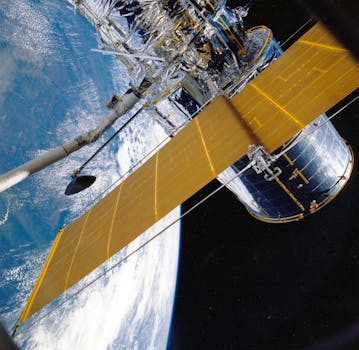
Beyond Earth: How Recent Advances Are Shaping Satellite Telecommunications
Beyond Earth: How Recent Advances Are Shaping Satellite Telecommunications. The field of satellite telecommunications has experienced significant growth in recent years, driven by advances in space technology, materials science, and computing power. As the demand for global connectivity continues to rise, satellite telecommunications are playing an increasingly important role in bridging the gap between remote and underserved communities. In this article, we will explore the recent advances that are shaping the future of satellite telecommunications and their potential impact on the way we communicate beyond Earth’s atmosphere.
Satellite telecommunications involve the use of artificial satellites in orbit around the Earth to transmit and receive data, voice, and video signals. The first commercial satellite, Intelsat 1, was launched in 1965, and since then, the technology has evolved significantly. Today, satellite telecommunications are used for a wide range of applications, including television broadcasting, telecommunications, navigation, and weather forecasting. Recent advances in satellite technology have enabled the development of smaller, more efficient, and cost-effective satellites that can provide high-speed internet connectivity to remote and underserved areas.
Advances in Space Technology
One of the key drivers of the recent advances in satellite telecommunications is the development of new space technologies. The miniaturization of satellite components, such as transponders and antennas, has enabled the production of smaller, more efficient satellites that can be launched at a lower cost. The use of advanced materials, such as carbon fiber and aluminum, has also improved the structural integrity and longevity of satellites. Furthermore, the development of new propulsion systems, such as electric propulsion and advanced ion engines, has enabled satellites to achieve higher speeds and longer lifetimes.
The use of CubeSats, small satellites that are typically cubes with a side length of 10 cm, has also become increasingly popular in recent years. CubeSats are low-cost, easy to launch, and can be used for a wide range of applications, including Earth observation, telecommunications, and scientific research. The development of CubeSats has democratized access to space, enabling universities, research institutions, and private companies to launch their own satellites and conduct space-based research and development.
Impact on Global Connectivity
The recent advances in satellite telecommunications are having a significant impact on global connectivity. Satellite internet constellations, such as those being developed by SpaceX and OneWeb, aim to provide high-speed internet connectivity to remote and underserved areas around the world. These constellations consist of thousands of small satellites in low Earth orbit, which can provide coverage to areas that are not currently served by traditional telecommunications infrastructure.
Satellite telecommunications are also being used to support disaster response and recovery efforts. During natural disasters, such as hurricanes and earthquakes, satellite communications can provide critical connectivity to emergency responders and affected communities. The use of satellite-based telecommunications can also help to restore communications infrastructure and provide vital services, such as healthcare and finance, to affected areas.
Challenges and Future Directions
Despite the recent advances in satellite telecommunications, there are still significant challenges that need to be addressed. One of the major challenges is the issue of space debris, which can pose a significant risk to operational satellites and other space-based assets. The development of sustainable and responsible practices for satellite operations and disposal is essential to mitigate this risk and ensure the long-term sustainability of space-based activities.
Another challenge is the need for greater international cooperation and regulation of satellite telecommunications. The use of satellite-based telecommunications can raise complex issues, such as spectrum allocation, licensing, and cybersecurity, which require coordination and cooperation among governments, industry stakeholders, and other interested parties. The development of clear and effective regulations and standards can help to promote the safe and responsible use of satellite telecommunications and ensure that the benefits of this technology are shared by all.


